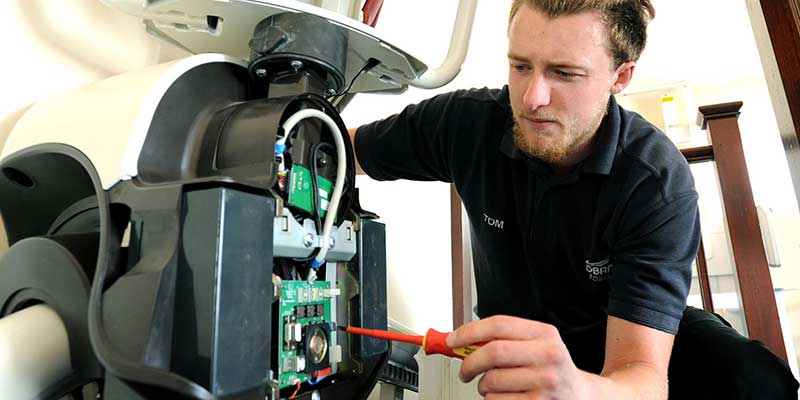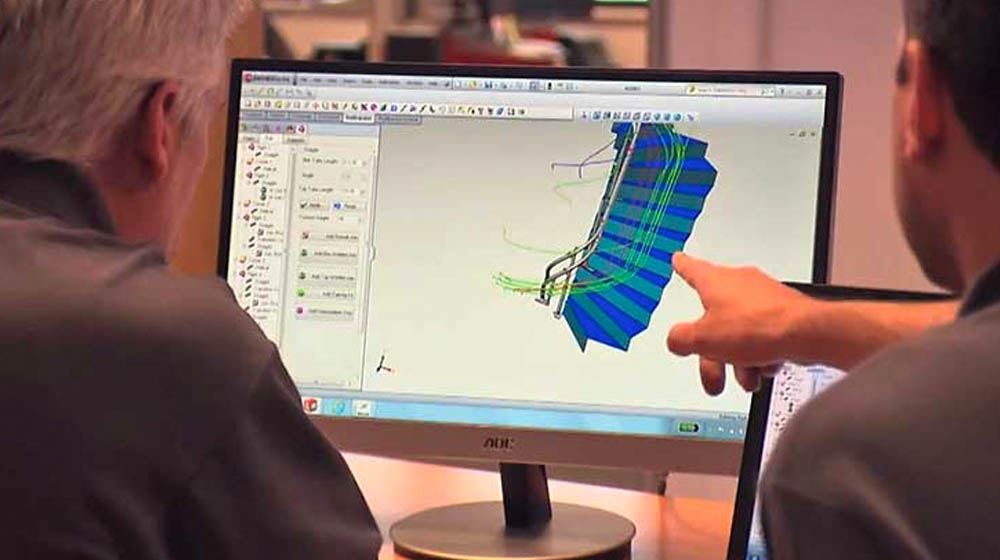The technology used in stair lifts is rapidly evolving to provide features not possible just a few years ago. As the aging population grows, a new market is emerging and stair lift companies are coming on the scene to provide a number of improvements in safety, efficiency, and comfort making aging in place easier.
Stair Lift Rails
In the past, stair lifts were attached to the stairs and the studs in your walls, making for an intrusive installation and causing significant damage if you needed to remove the stair lift.
Today, nearly all stair lift models are attached to stronger rails and supports that only secure to your stair’s treads. This new method of installation is cleaner, faster and doesn’t result in wall damage. In some instances, a wall support bracket may be required.
Additionally, custom fitting rails are the norm now. In the past, if you needed a custom-fit stair lift, rails were designed and cut specifically to your staircase’s specifications. Today, rails are easily cut and adjusted to size in a modular format. This is especially helpful if you have a curved staircase, so rail pieces can be fit together onsite in the shape of your staircase.
Finally, hinged rails allow stair lifts to be installed in places that would otherwise be a tight fit, like if you have a doorway at the end of your staircase or an extremely narrow staircase. With a hinged rail, when the stair lift is not in use, the carrier and seat travel to the top of the stairlift, allowing part of the track to fold up and out of the way. You’ll see manual and powered hinged rail options, with the power option being raised or lowered with the push of a button. If you choose an automatic hinged rail, the lift carrier is triggered by movement and comes with safety features like a light and buzzer to let you know the lift is in motion. Likewise, a buzzer will sound if the hinge is not raised, which can be a tripping hazard.
Stair Lift Seats
Stair lifts are designed for people with mobility issues, and for some of those people, even bending down or twisting to sit in a chair can be painful.
-
Swivel seats: Swivel seats allow users to stand directly on the landing instead of having to twist while standing on stairs. Some swivel chairs require the user to manually turn, but some swivel automatically, making the ride even easier. Most swivel seats come with a locking feature.
-
Perch seats: Also new in stair lift designs today are perch seats, which sort of look like a barstool. These seats require very little bending (but of course still have a seat belt and rails for safety) and move users in an almost standing position. These are perfect for stairways that may be a little more narrow than usual, and may even fit where an older stair lift couldn’t be installed.

Stair Lift Safety
A couple of new or improved safety features are common in modern stair lifts. These include:
-
Start and stop: Stair lifts today are designed to start and stop gently, as opposed to the past when you’d get a fairly prominent jolt at the start, which can be painful for people with aching joints.
-
Sensors: Modern stair lifts also have smart sensors in the chair’s footplate or footrest that stop if an object is detected along the path of the chair. This is a great feature for people who may have small animal companions around.
-
Backup battery: Stair lifts run on DC power but if the power to your home is cut off, modern stair lifts have a backup battery. The battery automatically charges when your stair lift is not in use and holds enough power for around six to eight trips.
-
Speed limiter: Stairlifts travel at around 0.16 to 0.34 miles per hour and are fitted with speed governors to prevent malfunctions with speed.
-
Pressure-sensitive operation: Many modern stair lift models come with a pressure-sensitive control, similar to a joystick. The user must hold the control for the stair lift to move and once the control is released, the stair lift stops automatically.
Stair Lift Controls and Power
A few notable improvements to how stair lifts are controlled and how they operate include:
-
Remote controls: Many people worry about getting stuck downstairs if their spouse or partner has previously used the stair lift to get upstairs. In the past, call buttons were installed at the top and bottom of staircases making for a more complicated installation process. Modern stair lifts come with remote controls which are held in a wall-mounted cradle.
-
DC power: Older stair lift models operated by using a main power supply cable that followed the chair up and down causing a tripping hazard. Thanks to DC power and motor improvements, motors are strong enough to move an adult and can be placed inside the chair with its own DC power-charged battery, eliminating trailing wires.
-
Weight limits: Thanks to improved stair lift rails, power and overall structure, modern stairlift models can carry a maximum weight of around 250 to 350 pounds.
The Last World on the Latest Stair Lift Technology
Stair lifts continue to improve. Today’s models make for a much smoother, safer ride, are far less permanent and damaging to walls, and can even be placed where previous models couldn’t.
Most manufacturers have showrooms where you can actually sit in different models to see which features you need. If you were researching stair lifts a few years ago and now you’re circling back to take another look, just be aware that you’ve got a number of new reasons to invest in one.


